Online Course
NURS 418 WB - A Public Health Approach to Violence Prevention
Module 4: Interpersonal Violence: Youth and Community Violence
Introduction
Injury and violence are among the leading causes of death for children, adolescents and youth aged 5-24. Whereas global deaths under age 5 are primarily driven by infectious disease and factors related to neonatal mortality, among older children, adolescents, and youth, the leading causes of death are injury, including road traffic accidents and drowning, interpersonal violence and self-harm.
United Nations Children’s Fund, Inter-agency Group for Child Mortality Estimation. (2020). Levels and Trends in Child Mortality (p. 24). https://www.unicef.org/media/79371/file/UN-IGME-child-mortality-report-2020.pdf.pdf
Nationally, over 656,000 children were subjected to maltreatment in 2019. Child victimization takes many forms, from neglect to sexual, physical or emotional abuse. In 2019, the most common form of child maltreatment was neglect. The vast majority of perpetrators are family members or known relatives; only 3.8% of child victimization perpetrators are someone other than a child’s relative.
U.S. Department of Health & Human Services, Administration for Children and Families, Administration on Children, Youth and Families, Children’s Bureau. (2021). Child Maltreatment 2019. https://www.acf.hhs.gov/cb/report/child-maltreatment-2019
Globally, interpersonal violence is the fourth leading cause of death in adolescents and young people. Its prominence varies substantially by world region. It causes nearly a third of all adolescent male deaths in low- and middle-income countries in the WHO Region of the Americas (North, Central and South America). According to the global school-based student health survey 42% of adolescent boys and 37% of adolescent girls were exposed to bullying. Sexual violence also affects a significant proportion of youth: 1 in 8 young people report sexual abuse.
Violence during adolescence increases the risks of injury, HIV and other sexually transmitted infections, mental health problems, poor school performance and dropout, early pregnancy, reproductive health problems, and communicable and noncommunicable diseases.
Effective prevention and response strategies include:
- Promoting parenting and early childhood development;
- Addressing school-based bullying prevention;
- Programs that develop life and social skills; and
- Community approaches to reduce access to alcohol and firearms.
Effective and empathetic care for adolescent survivors of violence, including ongoing support, can help with the physical and psychological consequences.
United Nations Children’s Fund, Inter-agency Group for Child Mortality Estimation (2020). Levels and Trends in Child Mortality, Report 2020 (p. 24). https://www.unicef.org/media/79371/file/UN-IGME-child-mortality-report-2020.pdf.pdf
Leading Causes of Injury Deaths by Age Group: Violence-Related Injury Deaths
See the figure below and look at the ranking for the specific causes of death in each age group (Click on link for clearer image)
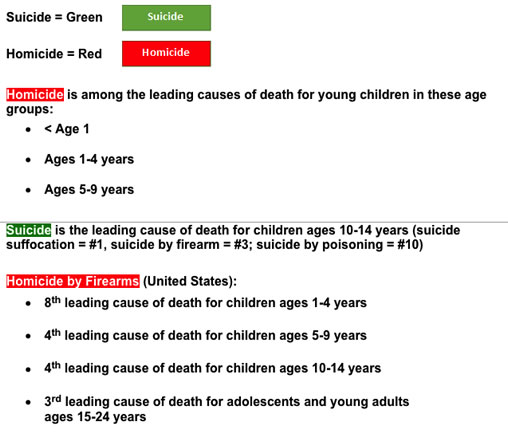
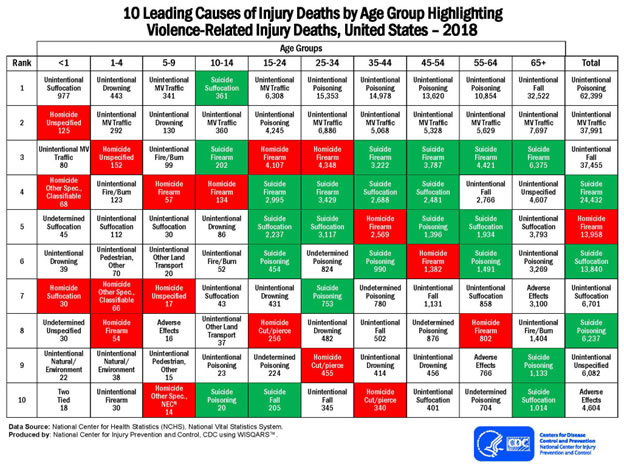
10 Leading Causes of Injury Deaths by Age Group Highlighting Violence-Related Injury Deaths, United States – 2018. https://www.cdc.gov/injury/images/lc-charts/leading_causes_of_death_by_age_group_violence_2018_1100w850h.jpg
Social Determinants of Health (SDH)
We cannot discuss any type of violence without an understanding of the Social Determinants of Health (SDH).
- Insufficient financial and other (natural, infrastructure, etc.) resources, weak governance, corruption, or unjust legal institutions, cultural, social and gender norms, inequalities of income/wealth, gender, race, employment, educational opportunities, and rapid social change are all social contributing factors- many based on policy.
- These factors create a climate that is conducive to violence.
Any comprehensive community or youth violence prevention strategy must buffer against creating this climate, especially through policy and measures to strengthen and support the justice and security sectors, and (or most importantly) the education, economic, social, and health sectors, as these are the social determinants of health that can assure that prevention strategies take hold and are effective.
Who/where is at risk for violence?
- Risk factors are characteristics that:
- Increase the likelihood of a person becoming a victim or perpetrator of violence, or of a place having high rates of youth violence.
- The more risk factors (for an individual or a setting), the higher the likelihood of involvement in violence or that violence occurs in a certain setting.
- Factors occurring in early childhood significantly increase the likelihood of involvement in later violence.
- Youth violence is defined as ages 10-29 years, but
intervention with earlier (0-6yrs) and later age groups (parents/caregivers) are critically important to prevention of
youth violence.
- We know that socio-ecologic factors, risk factors (and conversely prevention or resiliency factors) occur at the level of the individual, family and peer relationships, the community, and society.
- Socio-Ecological Models explain the occurrence of violence and help identify potential prevention strategies.
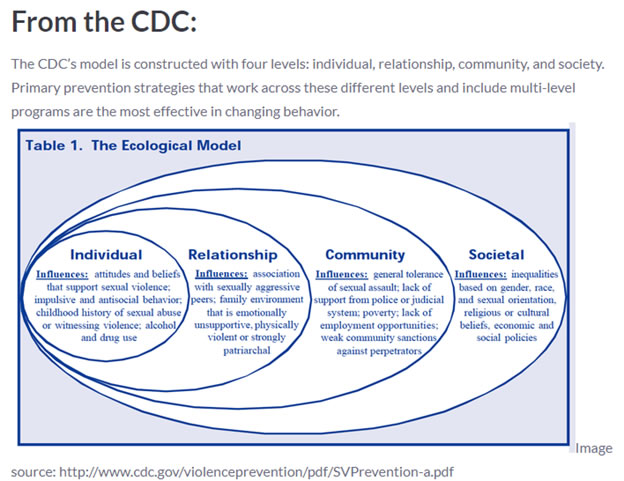
http://wiki.preventconnect.org/socio-ecological-model/
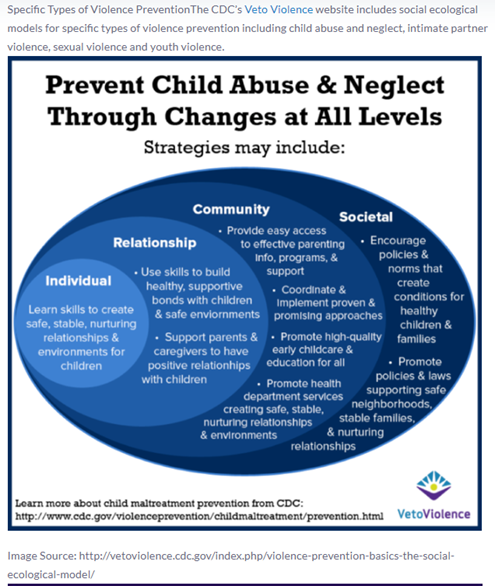
http://wiki.preventconnect.org/socio-ecological-model/
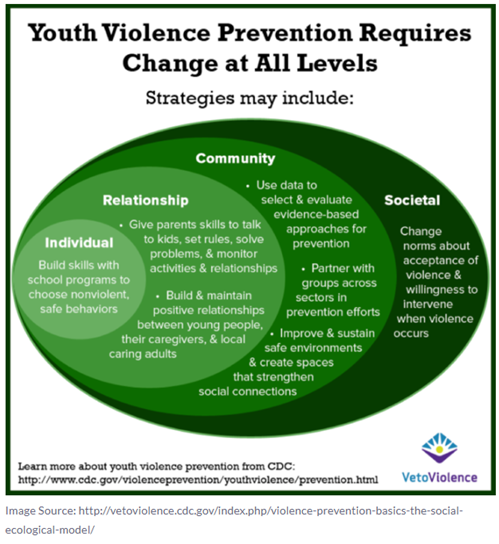
http://wiki.preventconnect.org/socio-ecological-model/
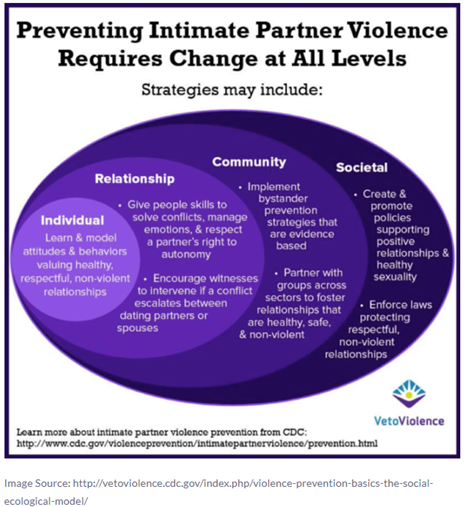
http://wiki.preventconnect.org/socio-ecological-model/
This website is maintained by the University of Maryland School of Nursing (UMSON) Office of Learning Technologies. The UMSON logo and all other contents of this website are the sole property of UMSON and may not be used for any purpose without prior written consent. Links to other websites do not constitute or imply an endorsement of those sites, their content, or their products and services. Please send comments, corrections, and link improvements to online@son.umaryland.edu.